The ongoing conflict between Israel and Hamas reached a grim milestone as it entered its 15th month, marked by a surge in violence and escalating casualties. On Thursday, Israeli airstrikes claimed the lives of at least 18 people in the Gaza Strip, including three children and two high-ranking Hamas police officers. The strikes further intensified the humanitarian crisis in the besieged territory, where hundreds of thousands of displaced Palestinians are struggling to survive amidst the devastation. One of the deadliest strikes targeted a designated humanitarian zone near Khan Younis, known as Muwasi, where displaced families had sought refuge in tents. The attack resulted in the tragic deaths of three children, three women, and four men, with an additional 15 individuals injured. This incident underscores the vulnerability of civilians, particularly those seeking shelter in supposedly safe areas, amidst the escalating violence. The continued targeting of humanitarian zones raises serious concerns about the protection of civilians and the adherence to international humanitarian law.
The Israeli Defense Forces (IDF) confirmed carrying out a strike aimed at Hassam Shahwan, the deputy chief of Hamas police, accusing him of assisting the militant wing in planning attacks against Israeli forces. Hamas, however, mourned the deaths of Shahwan and police chief Mahmoud Salah, portraying them as fulfilling their humanitarian and national duties. Another airstrike in the central Gaza Strip resulted in the deaths of at least eight people, including members of committees responsible for securing aid convoys, further exacerbating the challenges faced by humanitarian organizations operating in the region. The unrelenting violence continues to impede aid delivery and deepen the suffering of the already vulnerable population in Gaza. The escalating conflict and continued targeting of aid workers raise serious concerns about the ability of humanitarian organizations to provide essential assistance and support to those in dire need.
The latest surge in violence comes against the backdrop of stalled ceasefire negotiations, highlighting the immense challenges in achieving a lasting resolution to the protracted conflict. The war, which erupted in October 2023 following a Hamas-led attack on southern Israel, has claimed the lives of thousands of people on both sides, leaving a trail of destruction and displacement in its wake. The initial attack, resulting in the deaths of approximately 1,200 Israelis, mostly civilians, and the abduction of around 250 individuals, of whom around 100 remain captive in Gaza, continues to fuel the cycle of violence and retribution. The fate of the hostages, with reports suggesting at least a third may have perished, remains a central concern in the ongoing conflict. The prolonged captivity and uncertainty surrounding their well-being adds another layer of complexity to the already challenging humanitarian situation.
The humanitarian crisis in Gaza has reached catastrophic proportions, with local health officials reporting at least 45,000 Palestinian deaths, over half of which are women and children. These figures highlight the devastating impact of the conflict on civilian populations and underscore the urgent need for a ceasefire and a comprehensive resolution to the ongoing crisis. While the IDF claims its operations exclusively target militants, blaming Hamas for civilian casualties, these assertions are contested by Palestinian authorities and humanitarian organizations. The IDF’s reported elimination of 17,000 militants remains unsubstantiated, further fueling the debate surrounding the accuracy and proportionality of Israeli airstrikes. The lack of independent verification and transparency surrounding casualty figures further complicates efforts to assess the true impact of the conflict.
The war has inflicted widespread destruction upon Gaza, displacing nearly 90% of its 2.3 million residents. The ongoing conflict has not only resulted in a staggering loss of life but has also shattered the infrastructure and economy of the densely populated territory. The massive displacement of the population has created a dire humanitarian emergency, with hundreds of thousands seeking shelter in overcrowded camps and makeshift accommodations. The destruction of homes, hospitals, and essential infrastructure has further exacerbated the suffering of the Palestinian people, leaving them vulnerable to disease, malnutrition, and other life-threatening conditions. The long-term consequences of this protracted conflict, including the psychological trauma inflicted on the population, will continue to reverberate for years to come.
The ongoing conflict underscores the urgent need for international intervention to broker a ceasefire and facilitate a lasting peace agreement. The continued targeting of civilians and humanitarian infrastructure highlights the failure of existing mechanisms to protect vulnerable populations and uphold international humanitarian law. The international community must exert greater pressure on all parties to end the violence, ensure accountability for war crimes, and address the root causes of the conflict. A comprehensive resolution must prioritize the protection of civilian lives, address the underlying political grievances, and ensure the delivery of humanitarian assistance to the beleaguered population of Gaza. Failure to achieve a sustainable peace will perpetuate the cycle of violence and prolong the humanitarian catastrophe unfolding in the region.














